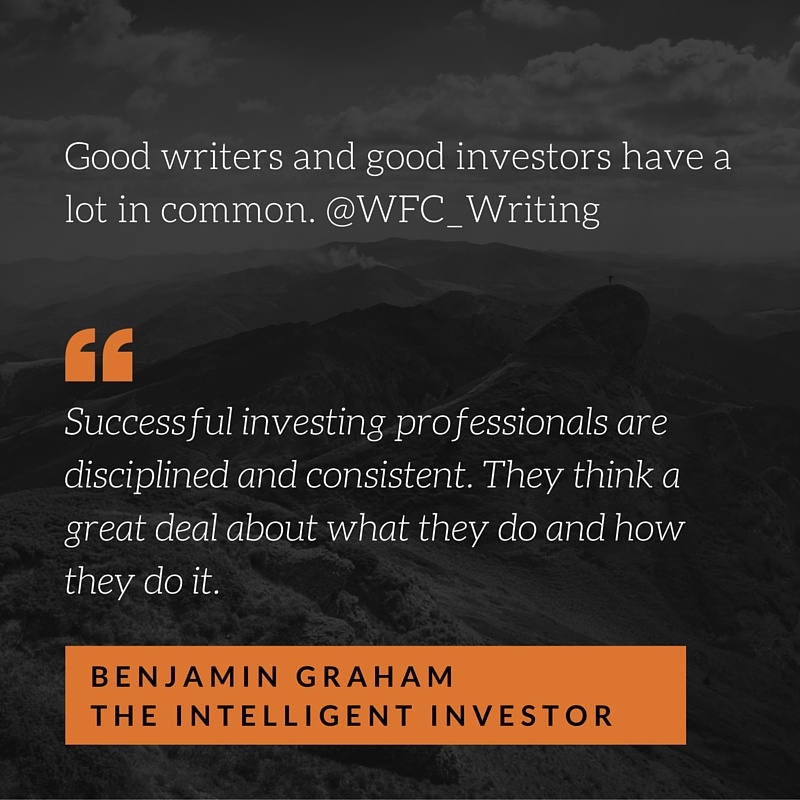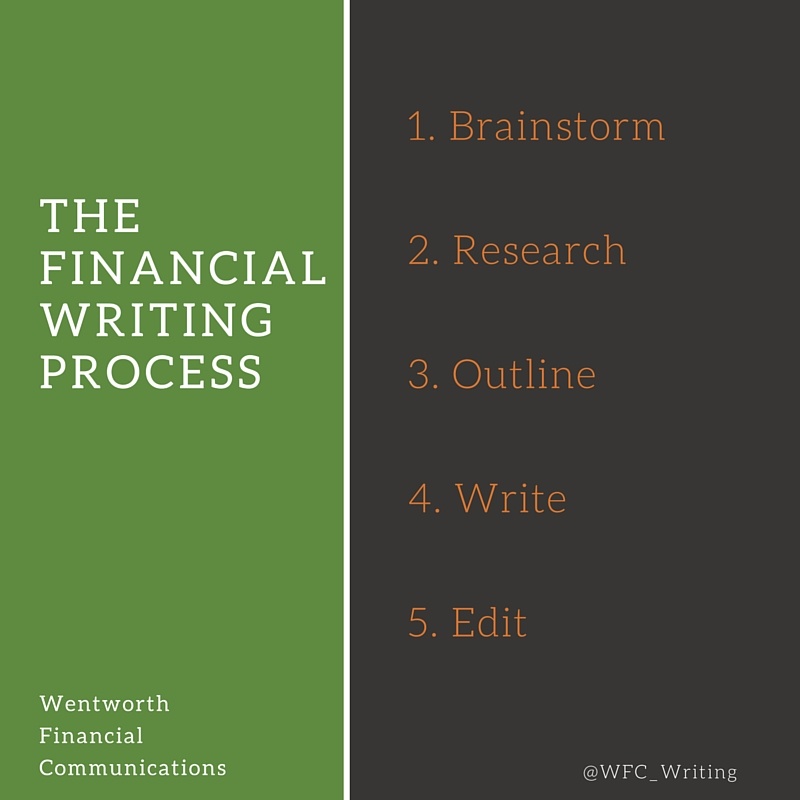Being a good financial writer has a lot in common with being a good investor. Both jobs require developing a process and sticking to it. Whether you’re looking to deliver alpha-generating investment ideas or thoughtful, quality writing, it’s important to follow a process.
In this post, we outline our writing process and explain how following these five steps can improve the speed, quality, and effectiveness of your writing.
Why “Non-Writers” Need a Writing Process
Regardless of what your official job description says, writing is an essential part of everyone’s job in financial services. Portfolio managers write quarterly market commentaries. Financial advisors write articles for client newsletters. Accountants write letters outlining tax strategies. Investment bankers write e-mails introducing buyers to sellers.
Writing, however, can be a daunting, time-consuming task for most financial professionals. Even if you write professionally like I do, sitting down and staring at a blank computer screen can be a scary proposition.
As a financial writer, I’ve found that the best way to improve the quality, speed, and consistency of writing is to understand that writing is a process. Just like portfolio managers need to adhere to a disciplined investment process to generate alpha for their clients, writers need to develop a process that works for them and stick to that process.

Steps of the Writing Process
Writing can be broken down into five distinct steps: 1) brainstorm, 2) research, 3) outline, 4) write, and 5) edit. I’ve found that a lot of the angst involved in writing occurs because people try to accomplish all five of these steps at once. By tackling these steps one at a time, it simplifies the process, allowing you to organize your thoughts and focus on the task at hand.
1. Brainstorm
First, think about what it is that you want to say to your audience. Then start jotting down on some scratch paper all of the supporting ideas that might be helpful in telling that story. Don’t worry about trying to organize these ideas or figure out which ones will make the cut. (That stuff comes later.) The point of brainstorming is just to get the ideas out of your head and onto the paper.
Let’s say you’re working on an annual letter to clients, thanking them for their business. During the brainstorming, list all of the possible points, big and small, you might want to reference in the letter. Your initial list might include company milestones, new products or services, new offices, opportunities for next year, personnel changes, and client success stories.
2. Research
The biggest cause of writer’s block is not having the information you need to make your point. During the research stage, go through your brainstorm list and figure out if there are any supporting details that you need to round up in order to explain the bigger points.
Getting back to the year-end client letter example, if you think you’ll want to list all of the new hires by name, go to your HR department and get a list of new employees’ names. If you want to highlight business milestones, ask the finance or marketing department to give you numbers from the past several years so you can quantify your firm’s growth.
3. Outline
I would argue that this is the most important step in the process. The outline is where you determine which ideas and supporting details go into the letter and what gets left out. It’s also where you organize your thoughts into a structure that makes the most sense to readers. Your outline can be as detailed or as high-level as you want. (Yes, I am giving you a pass to ignore your junior high English teacher who forced you to use Roman numerals and proper sub-headings.) The goal is to create a roadmap to guide you when you sit down to actually start writing.
For our year-end letter example, the outline is where you determine that the three points you want to include in the letter are company milestones, client successes, and opportunities for next year. It’s also where you determine that you want to lead with the client successes and finish with the opportunities for next year. Under each main point, you’ll want to list out any supporting details you plan on including. In the outline, you’ll also want to think about how you will transition from one point to the next in a smooth, natural way.
4. Write
Writing is the hardest step of the entire process. This is where you actually sit down at the computer and start typing. Because writing requires so much concentration, it is important to stack the odds in your favor by a) completing the previous steps before you sit down at the computer and b) eliminating distractions. You can eliminate distractions by closing your office door or turning off your e-mail. Some people—myself included—like to leave their office and find a spot where they know they won’t be interrupted.
Once you’ve found that distraction-free environment, take a deep breath and just start writing. Don’t worry about trying to make every sentence perfect. Just write it down and keep going.
5. Edit
Remember how I told you not to worry about making every sentence perfect? That’s because you have the opportunity to polish your writing during the editing stage. Once you finish your first draft, give yourself some time away from it before you begin editing. If you do not have enough time for an overnight break, take a walk or do something to clear your mind. Having that mental break will help you look at your draft with a clearer, more objective perspective.
Two tricks for good editing: 1) Have a colleague whom you trust to give you honest feedback review your work; a fresh set of eyes goes a long way in finding mistakes and ensuring that the flow of your ideas makes sense. 2) Before you hit send or print, read your work aloud to yourself; when you hear the sentence aloud, you will notice any minor mistakes, such as an omitted preposition or an awkwardly worded phrase, that can easily go undetected by the naked eye.
The Power of Process
Now that you know the steps of the writing process, you can approach the next writing project that lands on your desk with more confidence. Rather than viewing writing as one massive task, you’ll know that creating a quality piece of writing is the result of five simple steps that you can tackle one at a time.

About the Author
 Scott Wentworth is the founder and head writer of Wentworth Financial Communications, a firm that creates content marketing and thought leadership for financial services firms and law firms. Scott is such a big believer in the writing process that he used it to write his family’s Christmas letter this year.
Scott Wentworth is the founder and head writer of Wentworth Financial Communications, a firm that creates content marketing and thought leadership for financial services firms and law firms. Scott is such a big believer in the writing process that he used it to write his family’s Christmas letter this year.
{{cta(‘758bc2a7-eae9-4989-8aab-ac0dca499ac8’)}}
